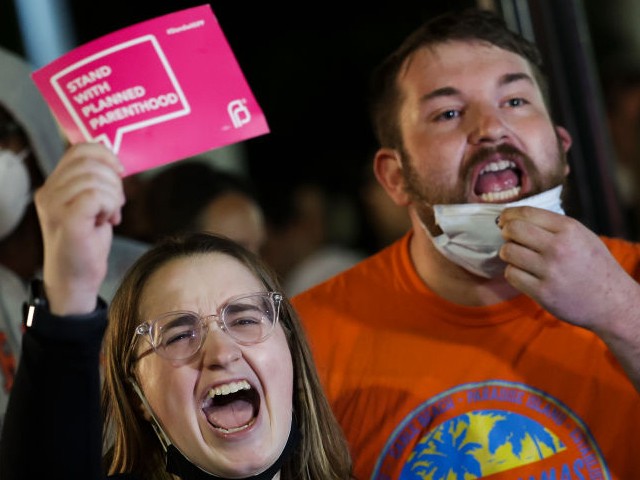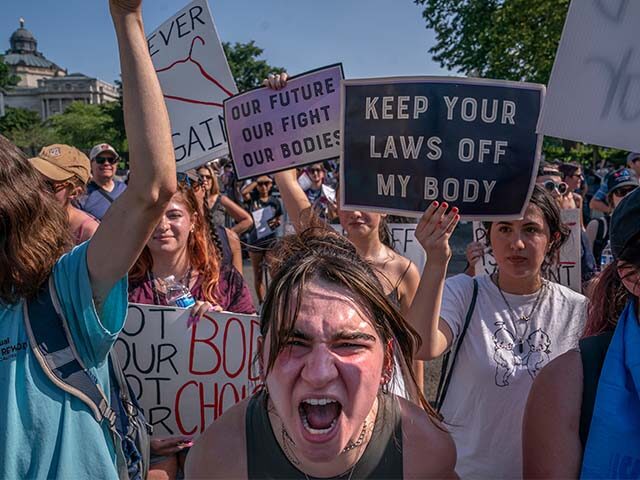Left-wing activists pushing a radical ballot measure that would enshrine abortion on demand into the Ohio constitution have massively out-raised pro-life groups leading up to the November 7 election.
Campaign filings from Ohioans United for Reproductive Rights, the coalition behind Issue 1, shows they have brought in nearly $29 million from donors since Sept. 8, the Associated Press reported on Thursday. Meanwhile, pro-life groups rallying against the measure have raised just under $10 million in the same period.
The largest donations backing the abortion amendment since Sept. 8 “came from out-of-state groups,” including $5.3 million from Arabella Advisors’ Sixteen Thirty Fund, a D.C.-based dark money group, the report states. The “yes” campaign also received $3.5 million from the New-York-based Open Society Policy Center, which is associated with billionaire left-wing Democrat donor George Soros. The American Civil Liberties Union (ACLU), also based in New York, gave the pro-abortion coalition $2 million, according to the report.

US-Hungarian businessman George Soros gives a TV interview during the United Nations Climate Change Conference in Copenhagen on December 10, 2009, AXEL SCHMIDT/AFP/Getty Images
“Billionaires Michael Bloomberg of New York and Abigail Wexner, the Ohio-based wife of retired Limited Brands founder Les Wexner, each gave $1 million,” the report states.
The campaign fighting Issue 1, called Protect Women Ohio, “accepted more than half its donations in the final months of the race from Protect Women Ohio Action Inc., a committee associated with the anti-abortion group Susan B. Anthony Pro-Life America,” the report states. It also received larger donations from the Ohio-based Knights of Columbus, a Catholic fraternal organization, and the Diocese of Columbus.
Press secretary of Protect Women Ohio Amy Natoce slammed the pro-abortion campaign’s outside funding in a statement to The Associated Press.
“It’s no surprise the ACLU is dumping millions of dollars into Ohio to cement its radical anti-parent amendment in our constitution,” Natoce said. “Whether voters are pro-choice, pro-life or somewhere in between, Issue 1 goes just goes too far and is too radical for Ohioans.”
Pro-abortion groups are also on track to outspend pro-life groups on ad buy ahead of election by $7 million, the report states, citing data from AdImpact.
Issue 1 would “establish in the Constitution of the State of Ohio an individual right to one’s own reproductive medical treatment, including but not limited to abortion.”
The ballot measure, put forward by a coalition comprised of far-left groups such as URGE, ACLU of Ohio, and Planned Parenthood Advocates of Ohio, would also:
- Create legal protections for any person or entity that assists a person with receiving reproductive medical treatment, including but. Not limited to abortion;
- Prohibit the State from directly or indirectly burdening, penalizing, or prohibiting abortion before an unborn child is determined to be viable, unless the State demonstrates that it is using the least restrictive means;
- Grants a pregnant woman’s treating physician the authority to determine, on a case-by-case basis, whether an unborn child is viable;
- Only allow the State to prohibit an abortion after an unborn child is determined by a pregnant woman’s treating physician to be viable and only id the physician does not consider the abortion necessary to protect the pregnant woman’s life or health; and
- Always allow an unborn child to be aborted at any stage of pregnancy, regardless of viability, if, in the treating physician’s determination, the abortion is necessary to protect the pregnant woman’s life or health.
Pro-abortion groups pushing the amendment have dumped significant sums into framing a “yes” vote on Issue 1 as a vote for “freedom,” and have invoked conservative imagery, opposition to government overreach, and mentions of “faith” and family” to convince Ohioans to support the killing of the unborn. Pro-abortion groups successfully employed a similar strategy in the 2022 midterms, when abortion was on the ballot in states like Kansas and Michigan.
But critics of the ballot measure have urgently warned that the amendment would decimate parental rights, lead to abortion throughout pregnancy, and even allow minors to pursue sex-change procedures. Members of the pro-abortion coalition have notably long campaigned to end parental involvement laws.
“Issue 1 is an all-out assault on parental rights. If passed, this dangerous initiative would abolish parental notification and consent requirements which protect minor girls from undergoing an abortion or even sex change surgery without her parents’ knowledge or involvement,” the pro-life group Ohio Right to Life previously said.
The ACLU of Ohio is responsible for crafting the broad original language of the proposed abortion amendment, along with other groups such as Planned Parenthood. Left-wing fact-checkers have quickly asserted that the amendment would not impact parental rights. But when local media questioned the ACLU of Ohio about whether the language of the measure would undo parental consent and notification laws, the organization vaguely indicated that those laws would not stand if the amendment passes.

Pro-choice and anti-abortion activist rally outside of the U.S. Supreme Court on May 02, 2022 in Washington, DC. In an initial draft majority opinion obtained by Politico, Supreme Court Justice Samuel Alito allegedly wrote that the cases Roe v. Wade and Planned Parenthood of Southeastern Pennsylvania v. Casey should be overturned, which would end federal protection of abortion rights across the country. (Photo by Kevin Dietsch/Getty Images)
Ohio election officials are predicting the issue may drive “heavier-than normal turnout for an off-year vote,” AP reported. Ohioans will also vote on whether to legalize recreational marijuana.
The November election follows another heavy-turnout special election over the summer, in which Ohioans voted against another amendment that would have raised the threshold to pass amendments to the state constitution from 50 percent plus one to 60 percent. If that amendment had passed, it would have likely made it more difficult for the abortion amendment to pass.
Some of the same dark money groups that support the abortion ballot measure spent nearly three-times what their opponents did in the August special election opposing the effort to raise the threshold. The Sixteen Thirty Fund contributed $2.5 million to the opposition, the Hopewell Fund contributed $650,000, and North Fund contributed $500,000. Opponents also received nearly $1.9 million from the Tides Foundation, another left-wing dark money group with close ties to Arabella.
The vast majority of the funding opposing the August amendment also came from outside of Ohio, with much of the funding coming from Washington DC, California, and New York.
Katherine Hamilton is a political reporter for Breitbart News. You can follow her on X @thekat_hamilton.

COMMENTS
Please let us know if you're having issues with commenting.